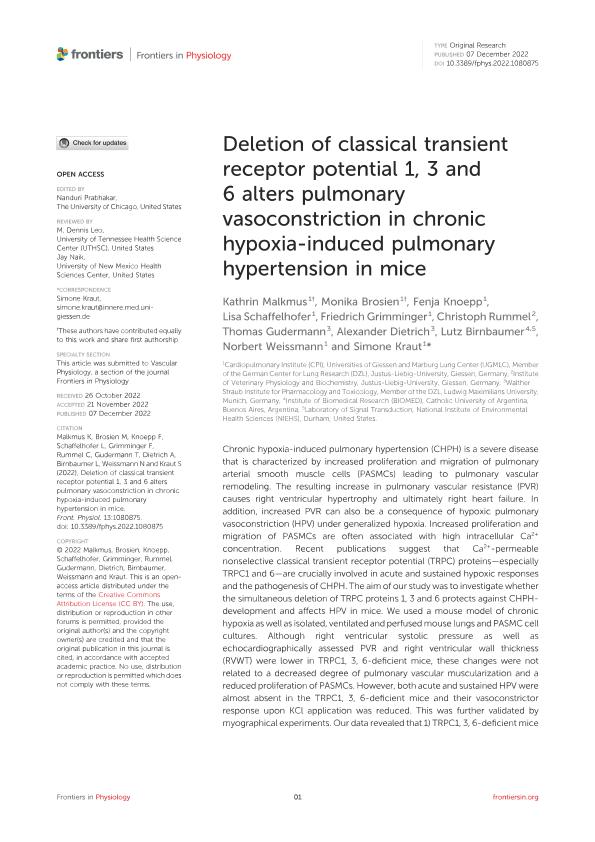Mostrar el registro sencillo del ítem
dc.contributor.author
Malkmus, Kathrin
dc.contributor.author
Brosien, Monika
dc.contributor.author
Knoepp, Fenja
dc.contributor.author
Schaffelhofer, Lisa
dc.contributor.author
Grimminger, Friedrich
dc.contributor.author
Rummel, Christoph
dc.contributor.author
Gudermann, Thomas
dc.contributor.author
Dietrich, Alexander
dc.contributor.author
Birnbaumer, Lutz

dc.contributor.author
Weissmann, Norbert
dc.contributor.author
Kraut, Simone
dc.date.available
2023-11-13T12:43:09Z
dc.date.issued
2022-12
dc.identifier.citation
Malkmus, Kathrin; Brosien, Monika; Knoepp, Fenja; Schaffelhofer, Lisa; Grimminger, Friedrich; et al.; Deletion of classical transient receptor potential 1, 3 and 6 alters pulmonary vasoconstriction in chronic hypoxia-induced pulmonary hypertension in mice; Frontiers Media; Frontiers in Physiology; 13; 12-2022; 1-15
dc.identifier.issn
1664-042X
dc.identifier.uri
http://hdl.handle.net/11336/217857
dc.description.abstract
Chronic hypoxia-induced pulmonary hypertension (CHPH) is a severe disease that is characterized by increased proliferation and migration of pulmonary arterial smooth muscle cells (PASMCs) leading to pulmonary vascular remodeling. The resulting increase in pulmonary vascular resistance (PVR) causes right ventricular hypertrophy and ultimately right heart failure. In addition, increased PVR can also be a consequence of hypoxic pulmonary vasoconstriction (HPV) under generalized hypoxia. Increased proliferation and migration of PASMCs are often associated with high intracellular Ca2+ concentration. Recent publications suggest that Ca2+-permeable nonselective classical transient receptor potential (TRPC) proteins—especially TRPC1 and 6—are crucially involved in acute and sustained hypoxic responses and the pathogenesis of CHPH. The aim of our study was to investigate whether the simultaneous deletion of TRPC proteins 1, 3 and 6 protects against CHPH-development and affects HPV in mice. We used a mouse model of chronic hypoxia as well as isolated, ventilated and perfused mouse lungs and PASMC cell cultures. Although right ventricular systolic pressure as well as echocardiographically assessed PVR and right ventricular wall thickness (RVWT) were lower in TRPC1, 3, 6-deficient mice, these changes were not related to a decreased degree of pulmonary vascular muscularization and a reduced proliferation of PASMCs. However, both acute and sustained HPV were almost absent in the TRPC1, 3, 6-deficient mice and their vasoconstrictor response upon KCl application was reduced. This was further validated by myographical experiments. Our data revealed that 1) TRPC1, 3, 6-deficient mice are partially protected against development of CHPH, 2) these changes may be caused by diminished HPV and not an altered pulmonary vascular remodeling.
dc.format
application/pdf
dc.language.iso
eng
dc.publisher
Frontiers Media

dc.rights
info:eu-repo/semantics/openAccess
dc.rights.uri
https://creativecommons.org/licenses/by-nc-sa/2.5/ar/
dc.subject
CHRONIC HYPOXIA-INDUCED PULMONARY HYPERTENSION
dc.subject
MICE
dc.subject
PROLIFERATION
dc.subject
PULMONARY ARTERIAL SMOOTH MUSCLE CELLS (PASMCS)
dc.subject
PULMONARY HYPOXIC VASOCONSTRICTION
dc.subject
PULMONARY VASCULAR REMODELING
dc.subject
TRPC
dc.subject.classification
Bioquímica y Biología Molecular

dc.subject.classification
Ciencias Biológicas

dc.subject.classification
CIENCIAS NATURALES Y EXACTAS

dc.title
Deletion of classical transient receptor potential 1, 3 and 6 alters pulmonary vasoconstriction in chronic hypoxia-induced pulmonary hypertension in mice
dc.type
info:eu-repo/semantics/article
dc.type
info:ar-repo/semantics/artículo
dc.type
info:eu-repo/semantics/publishedVersion
dc.date.updated
2023-11-09T14:17:46Z
dc.journal.volume
13
dc.journal.pagination
1-15
dc.journal.pais
Suiza

dc.description.fil
Fil: Malkmus, Kathrin. Justus Liebig Universitat Giessen; Alemania
dc.description.fil
Fil: Brosien, Monika. Justus Liebig Universitat Giessen; Alemania
dc.description.fil
Fil: Knoepp, Fenja. Justus Liebig Universitat Giessen; Alemania
dc.description.fil
Fil: Schaffelhofer, Lisa. Justus Liebig Universitat Giessen; Alemania
dc.description.fil
Fil: Grimminger, Friedrich. Justus Liebig Universitat Giessen; Alemania
dc.description.fil
Fil: Rummel, Christoph. Justus Liebig Universitat Giessen; Alemania
dc.description.fil
Fil: Gudermann, Thomas. Ludwig Maximilians Universitat; Alemania
dc.description.fil
Fil: Dietrich, Alexander. Ludwig Maximilians Universitat; Alemania
dc.description.fil
Fil: Birnbaumer, Lutz. Pontificia Universidad Católica Argentina "Santa María de los Buenos Aires". Instituto de Investigaciones Biomédicas. Consejo Nacional de Investigaciones Científicas y Técnicas. Oficina de Coordinación Administrativa Houssay. Instituto de Investigaciones Biomédicas; Argentina
dc.description.fil
Fil: Weissmann, Norbert. Ludwig Maximilians Universitat; Alemania
dc.description.fil
Fil: Kraut, Simone. Ludwig Maximilians Universitat; Alemania
dc.journal.title
Frontiers in Physiology
dc.relation.alternativeid
info:eu-repo/semantics/altIdentifier/doi/http://dx.doi.org/10.3389/fphys.2022.1080875
Archivos asociados
